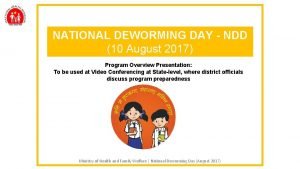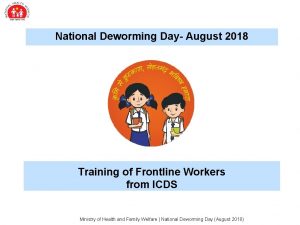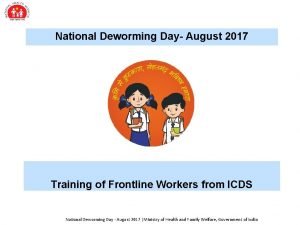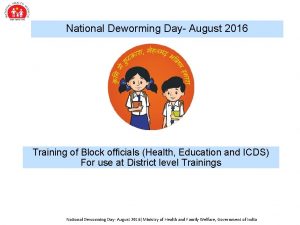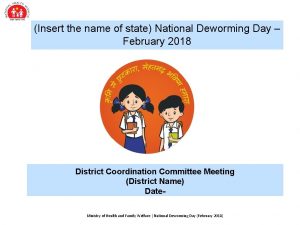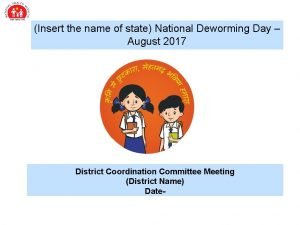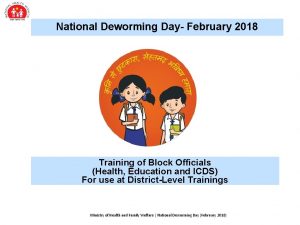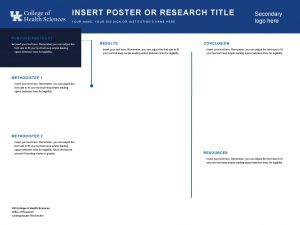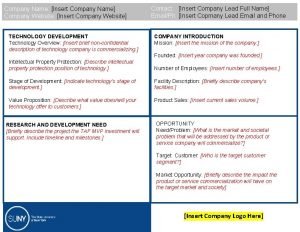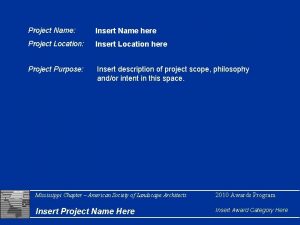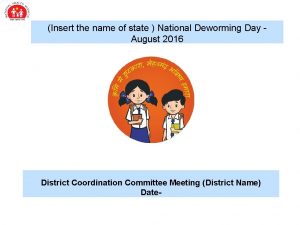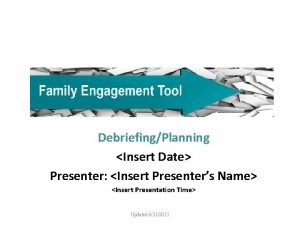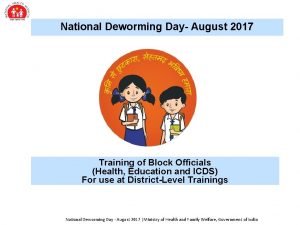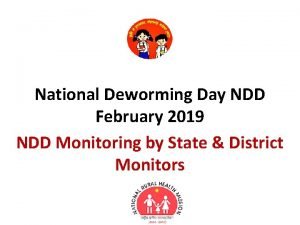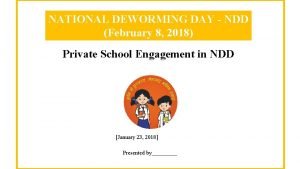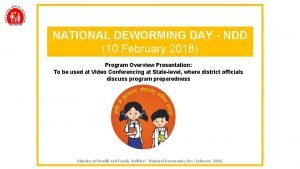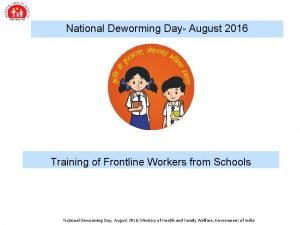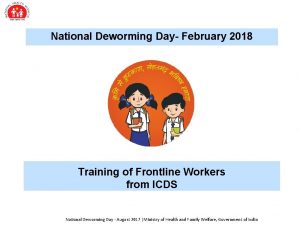Insert the name of state National Deworming Day































- Slides: 31

(Insert the name of state) National Deworming Day – February 2018 District Coordination Committee Meeting (District Name) Date- Ministry of Health and Family Welfare | National Deworming Day (February 2018)

Types of Worms • • Children aged 1 to 19 years (preschool and school-age children) are atrisk of parasitic intestinal worm infections, known as Soil Transmitted Helminths (STH) Worms are parasites that thrive on nutrition from the human intestine How do worms spread? • Worm infections result from poor sanitation and hygiene conditions • Worms transmit through contact with infected soil • The greater the amount of worms in a child (intensity), the more symptoms the infected individual will have Ministry of Health and Family Welfare | National Deworming Day (February 2018)

Worm Transmission Cycle 1 Source: Adapted from “Helminth control in school-age children: A guide for managers of control programmes” second edition, World Health Organization 2011 1. An infected child contaminates soil with faeces containing worm eggs. These eggs develop into larvae in the soil 2. Other children are infected by eggs ingested through food or dirty hands, or by larvae penetrating the skin 3. In an infected child, eggs and larvae develop into adult worms, which produce eggs and have an ill effect on the child's health Ministry of Health and Family Welfare | National Deworming Day (February 2018)

Impact of Worms Worm infections impair the nutritional status of the people they infect in multiple ways: • Worms feed on host tissues, including blood, which leads to anemia • The nutritional impairment has significant impact on growth and physical development • Worms consume nutrients meant for the human body and cause blood loss, poor nutrition and stunt growth • Roundworm may compete for vitamin A in the intestine Impact on Children’s Education and Long Term Productivity • Due to heavy infection, children are often too sick or tired to concentrate at school or attend school. • Worm infection negatively affect children’s physical and cognitive development, which could have long term negative impact on their work potential and wages in adulthood. Studies show that absenteeism in schools decreases by 25%, with regular deworming Ministry of Health and Family Welfare | National Deworming Day (February 2018)

Preventing Worm Infection Ministry of Health and Family Welfare | National Deworming Day (February 2018)

How to Treat Worms Deworming Drug- Albendazole 400 mg (available free-of-cost) Albendazole should be administered to all children aged 1 to 19 in age-specific doses Albendazole is a safe drug for both children adults and has been used to treat millions of people across the world for Soil Transmitted Helminths. Ministry of Health and Family Welfare | National Deworming Day (February 2018)

Benefits of Deworming Direct Benefits: • • Controls anemia Improves nutritional uptake Indirect Benefits: • • • Helps improve concentration, capacity to learn, and attendance at school and anganwadi Helps improve work potential and livelihood opportunity Benefits the community by reducing worms in the environment Ministry of Health and Family Welfare | National Deworming Day (February 2018)

Steps to be Followed at the AWC on NDD and MUD Albendazole administration • Teachers/anganwadi workers must use a spoon to administer Albendazole tablet to the child themselves and not give it to the parents to be given at home • Teachers/anganwadi workers must never administer the tablet to children who are sick or are on any other medication • Call______ for any medical assistance. Ministry of Health and Family Welfare | National Deworming Day (February 2018)

National Deworming Day-2017: An Overview and Achievement q Objective: To target all 1 -19 years children through platforms of schools and anganwadis q NDD February 2017 scaled to Campaign Mode on Feb 10 followed by mop-up day on Feb, 15 to target 34 States and UTs (697 districts) q Based on national-level STH mapping and WHO treatment guidelines, 34 states are required to conduct the biannual round of deworming on August 10 followed by mop-up day on August, 17 q NDD August 2017: 34 states and UTs (Targeted) States conducted NDD *August 2017 coverage data is awaited *11 States and UTs participated in phase one of NDD 2015 including (insert name of your state if included in NDD 2015 **22 States and UTs participated in the second round of phase two of NDD 2016 (insert name of your state if included in NDD August 2016 **34 States and UTs participated in phase two of NDD 2017 (insert name of your state if included in NDD August 2017)

Key Achievements of (insert state name) NDD August 2017 1 Indicators Results Number of children (1 -19 years) targeted Number of enrolled children (Class 1 to 12) dewormed at schools Number of registered children dewormed (1 to 5 years) at Anganwadis Number of unregistered children dewormed (1 to 5 years) at Anganwadis Number of out-of-school children (6 -19 years) dewormed at Anganwadis Total number of children 1 -19 years dewormed at schools and Anganwadis *Source- Total functionaries trained : ------ government and government-aided teachers, ----private school teachers, -----anganwadi workers, and ----- ASHAs State to adapt accordingly 1 Use February/August data as per the state implementation status Ministry of Health and Family Welfare | National Deworming Day (February 2018)

(State name) District-wise Coverage. NDD August 2017 District Indicators Results Number of children (1 -19 years) targeted in District Number of enrolled children (Class 1 to 12) dewormed at schools Number of registered children dewormed (1 to 5 years) at Anganwadis Number of unregistered children dewormed (1 to 5 years) at Anganwadis Number of out-of-school children (6 -19 years) dewormed at Anganwadis Total number of children 1 -19 years dewormed at schools and Anganwadis State to adapt accordingly if the biannual round was conducted otherwise mention NDD February 2017 coverage Ministry of Health and Family Welfare | National Deworming Day (February 2018)

NDD August 2017 – Comparison of District Coverage NDD Feb 2016 Insert the names of the district for which the coverage is shown in graph State to adapt accordingly from the district level reports Ministry of Health and Family Welfare | National Deworming Day (February 2018) ur U da ip i ra ul Ka jh un u Coverage in Percentage NDD Feb 2017 Jh un ar aw ur ip Ja Jh al um D an ga r h au sa i nd Bu H an Bh ar at pu r er m Aj Children dewormed (in figure) Sample graph for district wise coverage

Need for Deworming in State • State prevalence of Soil Transmitted Helminths (STH)___ • As per WHO guidelines, -------round of treatment is required to reduce the transmission of STH (States to put prevalence figures in this slide, along with state map) Ministry of Health and Family Welfare | National Deworming Day (February 2018)

(Insert State name) NDD FEBUARY 2018 • To deworm all children between the ages of 1 -19 years through government, government aided, private schools, and anganwadi centres on February 10, followed by mop-up day* on February 15, across ------ districts** Strategy for increased coverage - Scale private school and madarsa inclusion in ------districts - Strengthen engagement with Kendriya Vidyalaya, Navodaya Vidyalaya Departmen t of Health and family welfare - Standardize denominator of all target age groups- 1) Enrolled in Government and aided schools 2) Enrolled in Private schools 3) Registered at anganwadi (1 -5 years) 4) Out-of-school (6 -19 years) 5) Unregistered at anganwadi (1 -5 years) - ASHAs played a key role in mobilization of out-of-school children. Incentives provided to ASHAs as per NDD guidelines Women and Child developme nt(ICDS) School and Anganwadi based mass deworming *Mop up day to cover any child left out on NDD due to absenteeism or illness State to adapt accordingly Ministry of Health and Family Welfare | National Deworming Day (February 2018) Evidence Action Department of Education

(Insert State Name) NDD – February 2018 NDD 10 February 2018; Mop -Up Day 15 February 2018 Name of District : District Factsheet Target No. of blocks No. of government and government-aided schools No. of children enrolled in government & government-aided schools* No. of private schools No. of children enrolled in private schools No. of central schools (Kendriya and Navodaya Vidhyalaya) No. of children enrolled in central schools No. of AWCs No. of registered children in AWC (1 -5 years) No. of unregistered children in AWC (1 -5 years) No. of out-of-school children Total number of children targeted (1 -19 years) Sources: State to adapt accordingly Ministry of Health and Family Welfare | National Deworming Day (February 2018)

Roles and Responsibilities of the Health Department • Interdepartmental convergence • Ensuring availability of sufficient Albendazole tablets • Provision of Master Trainers to further train functionaries from Education/ICDS. • Develop and provide financial guidelines /budgets • Disseminate Adverse Event Management Guidelines • Develop IEC strategy and provide budgetary allocations • Printing of training material, IEC material and reporting forms • Inauguration of NDD at state and district-level to increase awareness • Ensure community mobilization through ASHAs to support deworming of out-of-school children • Monitoring and timely reporting of coverage data Ministry of Health and Family Welfare | National Deworming Day (February 2018)

Roles and Responsibilities of the ICDS Department • Support and coordinate with Health Department in effective roll-out of NDD • Train/orient anganwadi workers to administer drugs in coordination with Health Department and brief them on possible adverse events and their management • Ensue community mobilisation, especially of out-of-school children • Deworm all registered and unregistered children between the age of 1 -5 and all outof-school children in 6 -19 years of age • On mop-up day, administration on mop-up day to children who could not be dewormed on NDD due to absenteeism/ sickness • Monitoring and supportive supervision • Timely reporting Ministry of Health and Family Welfare | National Deworming Day (February 2018)

Roles and Responsibilities of the Education Department • Support and coordinate with Health Department in effective roll-out of NDD • Train teachers to administer drugs in coordination with Health Department and brief them on possible adverse events and their management • Community mobilization through School Management Committees, Health and Sanitation days, school assembly etc. • Deworm all enrolled children at schools • On mop-up day, administration on mop-up day to children who could not be dewormed on NDD due to absenteeism/ sickness • Monitoring and supportive supervision • Timely reporting Ministry of Health and Family Welfare | National Deworming Day (February 2018)

NDD February 2018 - Policy Advocacy • • Agreement on the district-wise target for each target category Release of joint directives to all block-level officials by…………. (Insert timeline). Release of letters from District Magistrate to private schools, Kendriya Vidyalaya and Navodaya Vidyala for participation in NDD Review of all three stakeholders (Health, Education, WCD) through District Coordination Committee Meeting (DCCM) to be completed by…………. . (Insert timeline). One DCCM between………. . (Insert timeline) for gearing preparations for mop-up day. Formation of Block Coordination Committee meeting (BCCM) under chair of SDM, Participation of Health, Education, WCD district officials at the Video Conference with state for review of preparations in…………. (Insert timeline) Coordination with Education and WCD to share updated contact database of the headmaster, nodal teachers (private schools, KV & NV), AWW, LS, ANM, ASHA to be shared with Health by ……………(Insert timeline) State to adapt accordingly Ministry of Health and Family Welfare | National Deworming Day (February 2018)

NDD February 2018 -Policy Advocacy Private school engagement • Crucial to reach out all 1 -19 years children including children enrolled in private school* • The involvement of private schools in the NDD will be led at the district under the guidance and chairmanship of the District Magistrate. • Participation of representative from private school association/nodal at the DCCM • Release of letters from District Magistrate to blocks and private schools for overall participation in the program and coordination in all program activities including • Training and Access to deworming related materials including drugs, IEC and training material including reporting form through distribution cascade, adverse event management and coverage reporting • Holding community awareness activities with private schools to garner support aimed at generating awareness regarding program *The ninth Annual Status of Education Report (ASER) reports 29% of total school enrollment at the national level in private schools. Ministry of Health and Family Welfare | National Deworming Day (February 2018)

NDD February 2018 - Drug Procurement and Logistics • Approximately ……………*Albendazole (400 mg) tablets required for program for school and preschool-age children in the district. • Availability of approximately………. . Albendazole tablets with………districts from NDD Aug 2017*. . ……………. . Tablets to be procured by health. Drug Testing to be ensured by Department of Health before drug distribution begins Drug Bundling • Block-wise drug bundling for schools and anganwadis to be initiated based on the bundling plan * Mention the source of the data *States to mention status of drugs available and required for the district Ministry of Health and Family Welfare | National Deworming Day (February 2018)

NDD February 2018 – Drug Logistics and Supply State warehouse Timeline: by-----, 2018 District Program Manager to pick up drugs from state warehouse Civil Surgeon Office (District) Nodal officer DPM at civil surgeon office will be responsible for delivering the drugs to Block Health Managers (BHM) and MOIC at PHC Timeline: by -------, 2018 PHC (Block) BHM and MOIC will be responsible to send the drugs to BRC and CDPOs In the training at Block Resource Center, BRPs will distribute NDD Kits (drugs, IEC, forms, handout) to headmasters or teachers block level training Timeline: by-----, 2018 MOICs and CDPOs will give the NDD kits (drugs, IEC, forms, handout) to Lady Supervisors and anganwadi workers in the combined training at PHC *States to adapt based on timeline and distribution channel Ministry of Health and Family Welfare | National Deworming Day (February 2018)

NDD February 2018 - Integrated Distribution • Timely printing of all training and IEC material by …………(Insert timeline) • Department of Health to ensure bundling of all program material (Banner, poster, Handoutreporting forms and drugs) through integrated distribution at the block and project/sectorlevel trainings of teachers/headmasters and anganwadi workers • Block-wise bundle need to be made available at block and PHC before block-level training • Coordination required from all three stakeholder departments for effective integration NDD kit= Tablets+ Training handout + IEC+ Reporting form Integrated distribution is vital to ensure availability of drugs and other supplies at schools/AWC on deworming day Ministry of Health and Family Welfare | National Deworming Day (February 2018)

NDD February 2018 Integrated Distribution Timelines Transportation of *NDD kits to districts (for both school and preschool children)– by ------- (Insert timeline) Transportation of NDD kits to BMO/BEOs/MOIC offices– by ------(Insert timeline) Distribution of *NDD kit to teachers/headmasters, Anganwadis workers in the Block/sector level training – by ------(Insert timeline) *States to adapt based on timeline and distribution channel Ministry of Health and Family Welfare | National Deworming Day (February 2018)

NDD February 2018 – Training Cascade District-Level NDD kits Block/PHC Level • Location - ………. . districts • Trainings - ………. (Insert numbers) • Participants – BPO/MO, BCM, BHM, MOCHC/PHC/Ayush Doctors/BEW/BRP, CDPO and other from Education, ICDS and representative from partner agencies • Tentative Timeline: …………. . (Insert timeline) • Participants: AYUSH team, ANM, ASHA, School principals/ teachers and ICDS functionaries Project-Level • Participants: All Lady supervisors Sector-Level • Participants: All anganwadi workers (AWW) *States to adapt based on training cascade Ministry of Health and Family Welfare | National Deworming Day (February 2018)

NDD February 2018 – Adverse Event Management • Effective adverse event management in place at all level state, district and below • Dissemination of protocols to all CMHOs, BMHOs and other officials and orientation on standard procedures • Guidelines issued to all blocks for adverse event management systems i. e. block emergency response team constituted, emergency numbers of ………………. /nearest health center shared with Education and WCD for further dissemination to schools and anganwadi • Coordination with RBSK team by district to respond to any adverse event reported on NDD • The MO-PHC should ensure that the medicines that are mentioned in the Adverse Event Protocol should be available in the health centre on NDD and mop- up day and functional referral services ready • Schools and anganwadi must have emergency helpline numbers and contact numbers of nearest MO-PHC/ANM (List of contact numbers preferably stuck/fixed on the entrance door or wall). • Reporting of severe adverse event cases on standard adverse event reporting form …………emergency number as adapted in state. Also adapt engagement with RBSK team as per state’s guidance Ministry of Health and Family Welfare | National Deworming Day (February 2018)

NDD February 2018 – Community Awareness and Sensitization IEC Activities undertaken Cable TV/Miking/Wall writing Community awareness through prabhat pheri, parents teachers meeting, morning assembly etc. (2 weeks prior to NDD) Use existing platform like VHNDs, VHSNCs for community mobilization, and generating awareness for NDD Implementation By Department of Health Department of Education WCD and Department of Health Monthly meeting at anganwadi centers with community (2 weeks prior to NDD) Community mobilization by ASHA of out-of-school children through ASHA to start at-least one week prior WCD Department of Health Launch event to be organized at district in the presence of District Magistrate and representation from all stakeholders department, with wider media coverage. Ministry of Health and Family Welfare | National Deworming Day (February 2018)

NDD February 2018 – Program Monitoring • Micro-plan for “on-field monitoring” to schools and anganwadis at state, district and blocklevel by Health, Education and WCD on NDD and mop –up day with committed budget under PIP. • RBSK Mobile Health Teams and AYUSH doctors at block-level will monitor the implementation of NDD in the field. Each team will visit at least four schools/anganwadis on both NDD and mop- up day each. • Recording of visit observation by all officials on standardized Monitoring checklist will be crucial for understanding areas of improvement. Reinforced under NDD guidelines 2018. • Submission of the NDD checklist along with reporting form from block onwards and above. Snapshot of NDD monitoring Checklist *States to adapt based on micro plan for field -level monitoring Ministry of Health and Family Welfare | National Deworming Day (February 2018)

NDD Mobile/Web Application • • • To be used at block-level for data entry To be used at district-level for data review and approval To be used at state-level for data viewing and analysis and submission of NDD February 2018 coverage report 2 versions: 1) mobile based (android app) 2) web version Consistent data reporting through all mediums (mobile/web app, paperbased) Paper based reporting National NDD mobile/ web reporting *Refer to NDD manual for more information on NDD app Ministry of Health and Family Welfare | National Deworming Day (February 2018)

NDD February 2018 – Reporting Cascade 1 Level School Functionary Responsible Submitted to Format Principal Respective ANM under whose area the school falls in School Reporting Format Anganwadi Reporting Format Submission date 2 Anganwadi AWW Respective ANM under whose area the AWC falls in 3 Anganwadi ASHA Respective ANM under whom ASHA is working ASHA –Standard Reporting Format 4 Sub-center level MO – BHPC To collect all School and Anganwadi Reporting Formats & ASHA Reporting Formats District M & E Officer Block-level Common Reporting Formats & Monitoring formats; including NDD app reporting 14 March 2018 District-level Common Reporting Formats & Monitoring formats including NDD app reporting 21 March 2018 5 6 7 ANM Block-Level MO-BPHC District-Level District M & E State Nodal Officer Child Health, Mo. HFW State-level Common Reporting Formats & Monitoring formats including NDD app reporting 20 February 2018 27 February 2018 30 March 2018 Data entry and collation from block onwards through NDD app/web portal will follow the same reporting cascade and timeline *States to adapt based on timeline for reporting cascade

Thank You Ministry of Health and Family Welfare | National Deworming Day (February 2018)
 Ndd albendazole dose
Ndd albendazole dose National deworming day
National deworming day National deworming day
National deworming day National deworming day
National deworming day National deworming day
National deworming day National deworming day logo
National deworming day logo National deworming day
National deworming day Deworming poster images
Deworming poster images Day 1 day 2 day 3 day 4
Day 1 day 2 day 3 day 4 Day 1 day 2 day 817
Day 1 day 2 day 817 National unification and the national state
National unification and the national state Name of logo
Name of logo Insert brand name
Insert brand name Insert your name
Insert your name Insert company name
Insert company name Insert your name here font
Insert your name here font Hurricane insert name
Hurricane insert name Insert your name here
Insert your name here Name three line segments
Name three line segments William beanes elementary
William beanes elementary Haiku and
Haiku and Day to day maintenance
Day to day maintenance As your room gets messier day by day, entropy is
As your room gets messier day by day, entropy is I don't know about tomorrow
I don't know about tomorrow Juliet diary entry act 2 scene 5
Juliet diary entry act 2 scene 5 Growing day by day
Growing day by day Observation of seed germination day by day
Observation of seed germination day by day Conclusion of seeds
Conclusion of seeds Geotropism
Geotropism I live for jesus day after day
I live for jesus day after day Rising he justified freely forever
Rising he justified freely forever Day one day one noodle ss2
Day one day one noodle ss2
